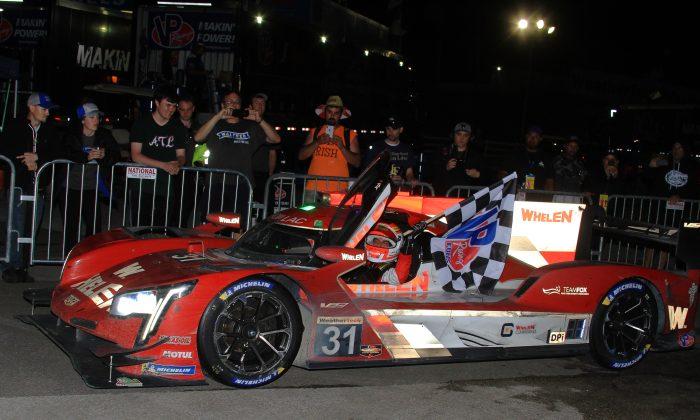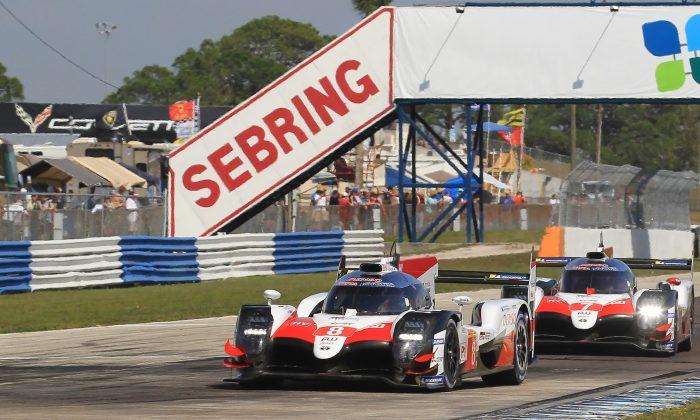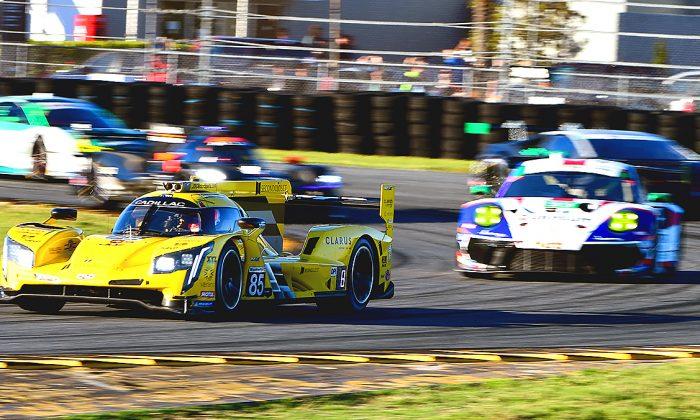Craig Lowndes, Peter Edwards, John Bowe, and Mika Salo in the #88 Maranello Motorsport Ferrari brought the Italian marque its first win at Australia’s famous Mount Panorama circuit Sunday, crossing the finish line a scant four-tenths of a second ahead of the #84 HTP Motorsports Mercedes SLS.
The race was about as good as an endurance race can get. Several different cars with different characteristics and different mixes of drivers used different strategies throughout the race to position themselves for the final hours, and ultimately for the final stint.
The Maranello Ferrari won, but any of several cars could have. All of the permutations of race strategy—when to change drivers, when to change tires, when to stop for fuel, when to use specific drivers—coupled with all the racecraft available to the stellar slate of drivers, each maximizing the characteristics of his or her car, combined to create a racing experience which was as exciting cerebrally as it was emotionally.
The first eight hours of the race featured some tremendously exciting racing, but that was just the prelude. The intensity of the competition increased steadily through the final few hours, as several cars swapped the lead both on track and in the pits. Strategy played as big a part as did speed, as teams had to calculate when to stop to get their fastest drivers into the cars for the final stints, balancing mandatory rest periods and maximum driver times against track position and fuel and tire economy.
Everyone had to calculate, and everyone had to gamble. With 35 cars circulating on a 6.2 -km track at maximum speed after so many hours of racing, there were more variables than known quantities. Chance played as big a role as math and engineering.

The Maranello Ferrari team gambled that they could stretch their fuel and keep the lead with Bathurst veteran Craig Lowndes at the wheel. The HTP Mercedes crew decided to change front brake pads with an hour to go, sacrificing track position; a move which seemed a mistake at the time, while the #37 VIP Holdings McLaren gambled on along green-flag run and stopped to top up the fuel tank, counting on Shane Van Gisebergen to make up lost places and come out ahead when the others had to stop for a splash.
With 20 minutes to go, it seemed the VIP team had guessed right; with the race looking to last 297 laps, only the fourth-placed McLaren had the fuel to make it to the finish. Craig Lowndes had the lead, but he was under pressure from the HTP Mercedes, whose fresh front brakes coupled with the huge torque of the Mercedes V8 enabled the car to cut through traffic to take second. Both cars were likely to be close on fuel—maybe they would win with a few drops left, maybe they would run dry with a few laps left.
All calculations went out the window when the #69 Porsche slammed the wall on top of the mountain, bringing out the safety car with 17 minutes left in the race. The safety crew cleaned up the mess in five minutes, but that five minutes of circulating slowly meant that everyone had enough fuel to make it to the finish.
The Shootout
When the safety car pulled off with 12 minutes left in the race there were three cars between Craig Lowndes in the leading Ferrari and Maximilian Buhk in the second placed HTP Mercedes. Four more cars back came the third-placed #63 Erebus Mercedes, and another half-dozen cars separated this car from the fourth-placed VIP McLaren.
As soon as the green flag waved, the first two cars behind the leading Ferrari dove into the pits. At the same time Shane Van Gisebergen rocketed past the intervening cars to attack the Erebus Mercedes. Buhk in the HTP Mercedes got onto Lowndes in the Maranello Ferrari, and the battles began.
Van Gisebergen had set a new track lap record earlier in the race, but his McLaren was tired after almost 12 hours of racing. On top of that, the Mercedes had more torque and power than the McLaren, so while Van Gisebergen to run right up on the Erebus car through the twisting section atop the mountain, the Mercedes could open a gap on the fast downhill and uphill sections. Van Gisebergen couldn’t get past the #63 Mercedes driven by Will Davison—the McLaren might have been able to catch and pass the leading Ferrari, but it never got the chance.

Up ahead, Maxi Buhk made the most of his new front brakes, closing in on the Ferrari at the end of each straight. Buhk got alongside the Ferrari a couple of times, but the big Mercedes didn’t have the handling to pass the Ferrari on the outside, and Lowndes never left the inside open.
After 12 hours of racing, the drivers of the #88 Ferrari stood atop the podium, beating the horde of usually dominant Mercedes, which are so well suited to this track. The Maranello Motorsports crew needed some luck to win, but they definitely earned the victory.
Had the Porsche not crashed, the outcome might have been completely different—Van Gisebergen might have inherited the lead when the other pitted, and probably could have protected it with the agile McLaren. The VIP team gambled and lost.
The final yellow was markedly different than the late-race yellow in the Rolex 24 two weeks earlier. At Bathurst, the crashed car was wedged against the wall in a dangerous location, so there was a real safety issue which called for a safety car. Also, track workers got everything cleared up in five minutes.
With or without the final yellow, the finish would have been exciting; of the five cars contesting the lead, four were on different strategies and in different conditions: The VIP McLaren traded track position for extra fuel, the HTP Mercedes traded track position for fresh brakes, the Maranello Ferrari chose to try to stretch its fuel, and the Erebus Mercedes just wanted to survive, having lost half its front end in a couple of collisions.
In the end, it came down to a short sprint, which spoiled some teams’ strategies and favored others. That’s racing.

What Makes a Good Race?
Not just the final few minutes, but the final few hours were tremendously exciting (and the first eight hours were pretty much of a barn-burner as well.) Endurance racing is about attrition, execution, and planning. It is also about adapting and recovering from adversity.
Both the #63 and the #84 Mercedes were involved in accidents early in the race (and the #63, in another later in the race.) The #88 Ferrari was penalized twice. These cars had to make up lost laps through strategy and driving ability, and had to keep focused on performance when victory looked impossible.
The #12B Ice Break Porsche seemed to be either leading its class or blowing out tires. This team did everything right, but fate threw up endless obstacles. It happens. (Even so, they held on for second in class.)
Endurance racing includes the spectrum of human emotions from the cheep and fleeting to the deep and lasting—from the quick thrill of a pass or a near crash to the growing appreciation of the plans and decisions teams and drivers make over the course of many hours.
The drama of endurance racing doesn’t come in a burst in a drag race to the checkered flag (though some of it did, this time.) The drama of endurance racing builds throughout the race as strategies unfold, as teams deal with good luck and bad. There is plenty of on-track action in any multi-class race to create immediate excitement—it is the deeper, slowly building tension of unfolding and development, punctuated with sudden spikes of excitement which give meaning to those final laps.
Bathurst was a great endurance race because it had intense racing throughout the 12 hours, because it had a huge variety of cars and classes, because it attracted some amazingly talented drivers, and because those drivers and their teams turned in exceptional performances.
As with all racing, a lot of it was luck. Bathurst could have been merely a good race if a couple of cars had crashed or broken at different times, or in different places, if certain drivers weren’t on track with certain other drivers, or if those drivers had been on track together but the running order or if any number of variables had been different. There is no formula.

As it turned out the Bathurst 12 Hours offered up 12 hours of exciting and enjoyable racing. The outcome is almost irrelevant; the experience, stretching through 12 hours, made the outcome merely another aspect of the event. Ferrari fans were pleased; Mercedes fans, maybe less so. McLaren fans, maybe disappointed.
Endurance racing fans were thrilled, scared, relieved, excited, intrigued, and finally satisfied. That’s what the sport is about.





